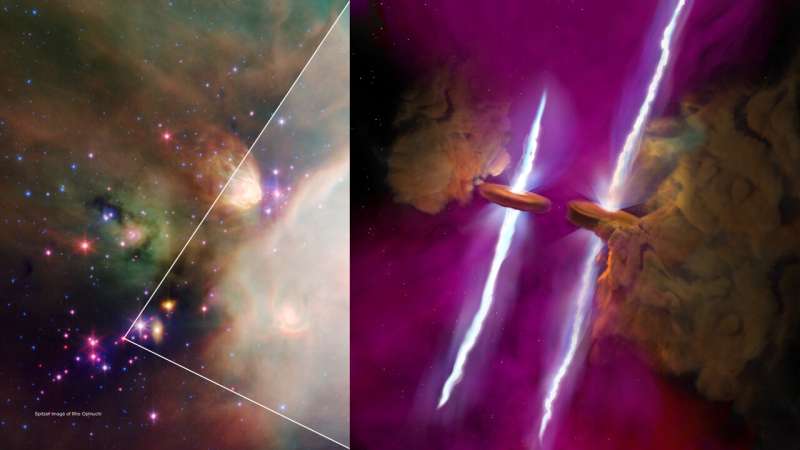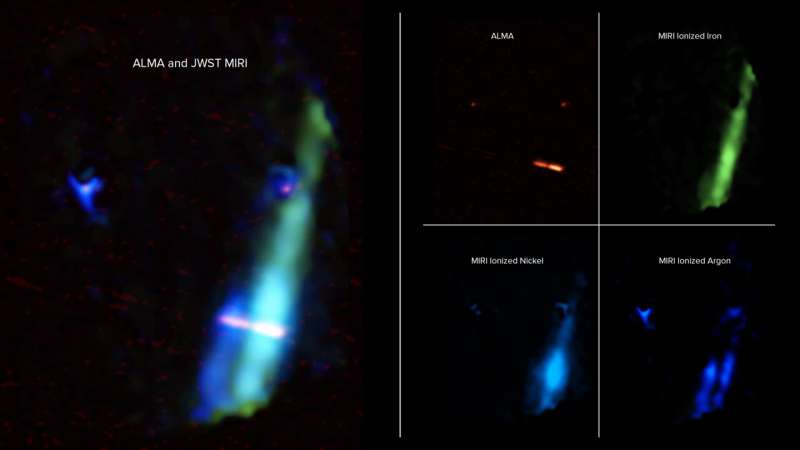This article has been reviewed according to Science X's editorial process and policies. Editors have highlighted the following attributes while ensuring the content's credibility:
fact-checked
trusted source
proofread
Astronomers discover parallel disks and jets erupting from a pair of young stars

Most of the universe is invisible to the human eye. The building blocks of stars are only revealed in wavelengths that are outside of the visible spectrum. Astronomers recently used two very different, and very powerful, telescopes to discover twin disks—and twin parallel jets—erupting from young stars in a multiple star system.
This discovery was unexpected, and unprecedented, given the age, size, and chemical makeup of the stars, disks, and jets. Their location in a known, well-studied part of the universe adds to the thrill.
Observations from the U.S. National Science Foundation's (NSF) National Radio Astronomy Observatory's (NRAO) Atacama Large Millimeter/submillimeter Array (ALMA) and NASA's James Webb Space Telescope's (JWST) Mid-Infrared Instrument (MIRI) were combined for this research.
ALMA and JWST's MIRI observe very different parts of the electromagnetic spectrum. Using them together allowed astronomers to discover these twins, hidden in radio and infrared wavelengths in star system WL20, located in the nearby rho Ophiuchi molecular cloud complex, over 400 light years away from the Earth's solar system.
"What we discovered was absolutely wild," shares astronomer Mary Barsony, "We've known about star system WL20 for a long time. But what caught our attention is that one of the stars in the system appeared much younger than the rest. Using MIRI and ALMA together, we actually saw that this ONE star was TWO stars right next to each other. Each of these stars was surrounded by a disk, and each disk was emitting jets parallel to the other."

ALMA spotted the disks, while MIRI found the jets. Co-author Valentin J.M. Le Gouellec of NASA-ARC retrieved and reduced ALMA archival data to reveal the disks' composition, while Lukasz Tychoniec of Leiden Observatory provided high-resolution images, revealing the disks massive size, approximately 100 times the distance between the Earth and the sun. Another co-author, Martijn L. van Gelder, provided resources to process the data collected by MIRI, revealing the chemical makeup of the jets.
Barsony adds, "So if it weren't for MIRI, we wouldn't even know that these jets existed, which is amazing."
ALMA's high resolution observations of the disks surrounding the two newly observed stars revealed the disks' structure, as Barsony explains, "Someone looking at this ALMA data not knowing there were twin jets would think, oh, it's a large edge on disk with a central hole, instead of two edge on disks and two jets. That's pretty remarkable."
Another remarkable thing about this discovery is that it may never have had the opportunity to happen. Explains JPL scientist Michael Ressler, "A lot of the research about binary protostars focuses on a few nearby star forming regions. I had been awarded some observing time of my own with JWST, and I chose to split it into a few small projects.
"For one project, I decided to study binaries in the Perseus star forming region. However, I had been studying WL20, which is in the rho Ophiuchus region in nearly the opposite part of the sky, for nearly 30 years, and I thought, 'why not sneak it in? I'm never going to get another chance, even if it doesn't quite fit with the others." We had a very fortunate accident with what we found, and the results are stunning."
By combining multi-wavelength data from ALMA and JWST, these new findings shed light on the complex processes involved in the formation of multiple star systems. Astronomers plan to utilize ALMA's future upgraded capabilities, like the Wideband Sensitivity Upgrade, to continue unraveling the mysteries surrounding the birth of stars and planetary systems.
Provided by National Radio Astronomy Observatory




















